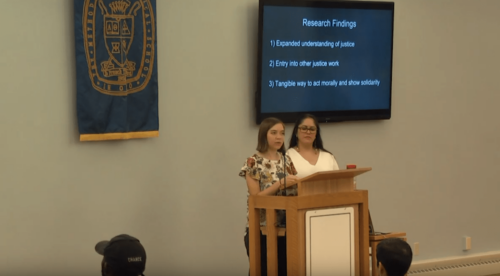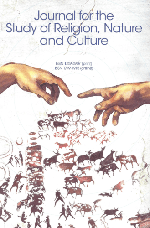Digging Deeper on Gender and Food Justice – Interview with Kelsey Ryan-Simkins
We are excited to share our latest interview with ISSRNC scholar and student board member Kelsey Ryan-Simkins. Interview by ISSRNC’s member chris crews.
I caught up recently with one of our ISSRNC junior scholars to talk about her work on gender and food justice and I’m excited to share the following edited interview based on that discussion.
Digging Deeper on Gender and Food Justice
ISSRNC: I want to start out with a little background for our readers. When did you first become interested in issues of justice, whether related to social issues generally, or more specific to food and gender? Was there something in your life that pushed you towards these sorts of questions?

ISSRNC board member and PhD student Kelsey Ryan-Simkins.
KRS: When I was an undergraduate university student living in Milwaukee, I began to see how many of the justice issues, both social and environmental, that I care about could be viewed through the lens of food. Milwaukee is highly segregated by socioeconomic status and by race, which maps onto a food landscape with uneven access to fresh food. Early during my time living in Milwaukee, I volunteered with Growing Power, one of the earliest urban agriculture projects in the U.S. to receive national attention for its transformation of vacant lots into a fully operational farm. It was an exciting place with hoop houses heated by piles of compost created by red wiggler earthworms and hundreds of liters of water circulating through an aquaponics system that grew leafy green vegetables and tilapia.
However, I was most engaged by the vision to produce fresh food in a neighborhood with low access, to hire local residents as farmers, to teach youth about environmental sustainability. Since then, I have been involved with a number of urban farms and sustainable food projects that seek to reinvent the food system to address systemic issues of injustice. These experiences have informed my research questions about how people participate in actions toward food justice, what motivates them, and how their values shape their work.
ISSRNC: Scholars have a tendency to use complex ideas without always being explicit as to how they are defining them. So let me ask, how do you define gender justice and food justice in your own work? And why do you think these two issues are important to think about together?
KRS: I define food justice as a food system that is ecologically sustainable and socially equitable, ensuring the right to food that is fresh, healthy, affordable, and culturally appropriate. The food justice movement calls for an end to systemic exploitation and oppression at every level of the food chain, recognizing that inequalities based on race, class, gender, and other identities shape food production, distribution, and consumption in our current global food system. In the U.S., the food justice movement is especially attentive to the ways in which racism has played a major role in food system injustices from reducing access to fresh affordable food in communities of color to the exclusion of Black farmers from U.S. Department of Agriculture programs and loans.

‘Women’s Participation in Food Justice: Developing Transnational Solidarity’ talk with Elaine Nogueira-Godsey and Kelsey Ryan-Simkins.
ISSRNC: In an event last fall at Methodist Theological Seminary of Ohio (MTSO) you talked about your fieldwork with a number of gardens and food groups in Ohio. Can you tell us a little more about this research and any important insights that may have come out of this research?
KRS: For my master’s thesis, advised by Dr. Elaine Nogueira-Godsey, I was a participant observer for 11 months and completed interviews with a dozen individuals involved with Franklinton Farms, a nonprofit urban farm in Ohio. My research sought to understand how religion and spirituality informed participants’ motivations for being involved with the farm and approach to food justice. One key finding that Elaine and I discussed in the talk at MTSO and in our forthcoming chapter in Valuing Lives, Healing Earth, is that participants found farming to be a tangible way to take action that resists the social and environmental injustices that take place in the globalized industrial food system. Interestingly, many participants also expressed how learning about these injustices through their engagement with the food justice movement caused them to reconsider and reconstruct their religious values.
ISSRNC: I wanted to ask about something that came up in the Q&A after your talk, and is an issue that often appears in discussions about food justice. I was at the recent Youth Climate Strike in Cleveland Ohio and there was a large contingent of vegan activists and an overriding theme of several speakers was focused on the harms of eating animals. Someone even had a sign that read “A meat-eating environmentalist is an oxymoron.” From a food justice perspective, do you think everyone needs to stop eating meat to save the planet, or is this too simplistic of a claim? Can you unpack this issue of food consumption choices and global food justice a bit?
KRS: I think it is too simplistic to argue that everyone needs to stop eating meat to save the planet. However, I do think eating a plant-based diet and reducing meat consumption are important individual actions to take, especially in highly industrialized nations like the United States. From an ecological perspective, incorporating animals into diverse agricultural systems provides a way to close waste streams and replenish soil nutrients for planted crops. Globally, animals have played an important role in many types of subsistence agriculture across different ecological contexts. Industrial agriculture, both monoculture grain production and factory-farm meat production, which dominate in the U.S., disrupt natural ecological cycles and subsistence strategies.
As industrial production spreads globally and consumption of meat increases per capita, we will see meat increase as a contributor to environmental issues and need to talk about meat consumption. Social inequalities also accompany this shift, including diminishment of women’s role in agriculture, high suicide rates among farmers, and race and class-based disparities in who can afford meat raised in ecologically sustainable systems. The food justice perspective calls for attention to these factors in addition to concerns about environmental harm. In my opinion, claiming that any amount of meat consumption is inherently harmful to the environment prevents people from having productive dialogue about where meat comes from, how animals fit into a healthy ecologically balanced agricultural system, and who is harmed by the dominant industrial food system.
There are many people who choose not to consume meat for ethical and religious reasons, and much can be learned about rethinking human-nonhuman animal relationships from their perspectives. Questions about how we, as humans, relate to the more-than-human world are central to solving environmental problems and will affect how we produce food. However, I do not think there is a single right answer to these questions that will fit every social and ecological context and am doubtful that the conclusion that eating meat is counter to environmental values can be universalized globally.
ISSRNC: I also wanted to ask about the ISSRNC. Can you tell us a little about how you see your work fitting into the field of religion and ecology? How do you connect your work to a broader audience who might not see the intersections of religion, nature and culture as that important?
KRS: I find food to be a salient place to examine the relationship between religion, nature, and culture. Producing and consuming food is an inescapable way that human beings interact with and alter nature. It also reminds us of our dependence on the more-than-human world. The choices human communities have made about agriculture often reflect religious values and ethics. Additionally, I understand food systems as a space in which we can see and interrogate social inequalities like racism and sexism.
As an environmental sociologist, the primary bodies of literature that I engage on food and agriculture have been largely inattentive to the role of religion in food and agriculture movements. My research has sought to explore these connections, especially in secular food spaces where different religious perspectives intersect with environmental concerns and social justice.
ISSRNC: Finally, for anyone interested in learning more about these issues, do you have 2-3 resources you would recommend that people could use as entry points to learn more?
KRS: For an introduction to the latest research on the food justice movement in the United States, I would recommend The New Food Activism, edited by Alison Hope Alkon and Julie Guthman (University of California Press, 2017), and Food Justice Now! by Joshua Sbicca (University of Minnesota Press, 2018). I also highly recommend the work of the Coalition of Immokalee Workers, a worker-led organization of Florida tomato pickers that advocate for fair working conditions and pay for farmworkers, and the Black Church Food Security Network, a Baltimore food network started by Baptist pastor Rev. Dr. Heber Brown III in Baltimore, Maryland to connect Black churches with Black farmers. Both are great examples of the food justice movement in the U.S. and the indirect and direct ways religion plays a role in mobilizing communities for food justice.
ISSRNC: I want to thank you for taking the time to talk to us today!
About the Author
Kelsey Ryan-Simkins is a PhD student in the School of Environment and Natural Resources at The Ohio State University and holds a masters degree from the Methodist Theological School in Ohio. As an environmental sociologist, her research focuses on food justice and the creation of environmentally sustainable and socially equitable food systems in the United States. Her current research aims to understand the historical, cultural, and political dimensions of urban agriculture projects in the United States and how these projects contribute to an equitable urban food system. Kelsey is also involved with several applied projects that aim to implement equitable food system transformation through the exploration and establishment of food hubs in marginalized neighborhoods in Columbus, Ohio. You can follow her work online @krsimkins.












